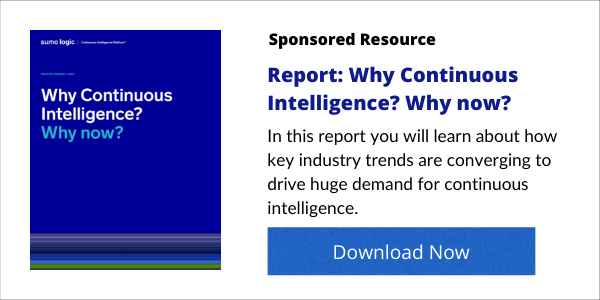
Continuous intelligence can help enterprise leaders deal with complexity in operations, security and business intelligence.
In the rush to roll out new business models, adaptable processes and new technologies enterprises have created a growing problem. It’s an organizational complexity that challenges managers and operations staffs to a point beyond human capabilities.
Enterprises reinvented themselves over the past two decades. Multiple cloud services replaced on-premise applications. Specialized partners became extensions of corporate staff. Now, in-house developers now write code designed to run anywhere, not on a dedicated server.
Watch Video Now: Digital Complexity and How to Address ItMeanwhile, the entire business and the experience of its customers are reliant on bits and bytes running across silicon. As a result the nature and success of the business is subject to ongoing changes in the data, the network, and system security. Those changes occur not just on a daily basis but sometimes in a microsecond.
Prime areas for continuous intelligence
With all that complexity, an operations staff and the corporate decision makers face a mash up of system and security alerts. They are left to wonder which data points they can or should act upon.
Three application areas present the greatest complexity: Operations, security and business intelligence.
Here’s a look at what organizations face in those three areas, and how technology itself – continuous intelligence — may help to deal with the challenges complexity has wrought.
See Also: Continuous Intelligence Insights
Complexity in operations
The Harvard Business Review offered up a definition for organizational complexity that is largely applicable to operations in this time of outsourcing, cloud computing, remote access and the Internet of Things. It said complexity is “a large number of different elements (such as specific technologies, raw materials, products, people, and organizational units) that have many different connections to one another.”
Doesn’t that describe the modern computing infrastructure, org chart, and supply chain?
For IT professionals, complexity seems to be part of life. Even when companies utilized monolithic mainframes with access limited to dumb terminals, managing IT wasn’t easy. There were constant updates needed, applications took years to build, and data center environmentals were a concern.
Today, however, organizations strive for everything to be digital with 24×7 access from anywhere on any device. Success with a tech rollout actually adds to complexity, according to MIT educator and research Jeanne Ross. “But successful solutions quickly give rise to demands for expanded services, greater personalization, and, ultimately, more variability. What was once a simple, powerful vision becomes complicated by a slew of options,” wrote Ross last year.
Automating one business function inspires management to automate others. Moving one application to the cloud leads to a broader SaaS strategy. Diversifying the cloud footprint across multiple clouds gives IT more providers to manage. Enabling work from home opens access and security concerns.

Why things go wrong
When the company’s myriad monitoring tools flag a performance issue the operations team must identify the cause, buried in a maze of systems, services, databases, connections, dependencies and applications. Add in the fact that alerts from such monitoring tools can number in the thousands – some serious, some routine — each day and the operations staff is overwhelmed.
What continuous intelligence (CI) brings to the table is a basis in artificial intelligence (AI) and machine learning. CI learns which services are most important to the organization. It identifies what is considered “normal” operations versus an aberration. When an issue pops up, it tells staff where it originates and how to fix the problem. CI gains experience over time, and it is on watch day and night, ready to suggest solutions. It can respond faster than a human operator. It also frees the human from having to sort through mundane alerts, allowing them to focus on more innovative work.
Complexity in security
The enterprise data security team faces the same types of challenges as their associates on the operations staff. One very big difference: Urgency.
The response to an alert about sluggishness in a non-critical application arguably could be “left for the day shift”. But an alert for a potential security breach requires a response measured in minutes or seconds. The company’s data, brand, revenue and reputation are on the line.
CI in a security information and event management (SIEM) role can offer security teams protection by identifying gaps between coverages in the security infrastructure that humans may not detect. That includes rapid response to attacks, coverage across a distributed computing environment, and the ability to deal with inputs from varied niche tools.
In that scenario, CI has the ability to offer a unified view of many diverse systems and pockets in a security strategy. It helps to bring some level of simplicity to the complexity that seems to grow each time the organization adds new business offerings.
Business intelligence grows up
Business intelligence (BI) has been at the heart of data analytics initiatives for decades. BI initially was treated as an off-line capability. A team of BI specialists analyzed data collected in recent weeks or months, drawing on only a copy of the relevant databases. They then turned over a report on their findings to senior management, never having touched the operational systems. In some instances, the BI team worked physically isolated from the IT operations group.
The second iteration of BI was to integrate analytics with applications such as those in an enterprise resource planning (ERP) suite. That offered the BI team and line managers the chance to view trends and see where the business was performing well or poorly.
Yet there still was little immediacy in BI. The analysis and any resulting alerts were based on what happened hours, maybe days, too late for action.
Continuous intelligence adds a real-time element to BI.
By leveraging machine learning and artificial intelligence, CI monitors key business performance indicators around the clock. It does so without requiring developers to rewrite the core business applications.
For example, CI can provide insight into customer experiences based on monitoring logs, including which product features customers use at a given time. CI offers the advantage of analyzing data drawn from multiple performance monitoring tools to gain a real-world view of its products or services in the real world.
The predictive analytics aspect of CI help the business spot issues before they occur, while allowing managers to double down on their successes. A prescriptive analytics capability then suggests proactive action by support teams or through automation as needed.
Summary
Viewed as a whole, the three key areas that CI can address allows enterprise leaders to better manage their operational systems. They can secure valuable data against intruders and respond to the ups and downs of a business in real time.
Watch Video Now: Digital Complexity and How to Address It





